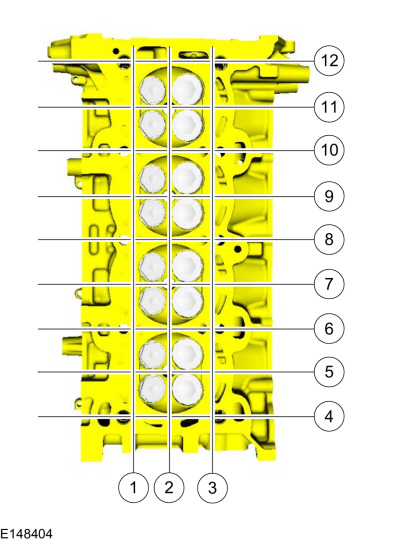Ford Ecosport: Engine System - General Information / General Procedures - Cylinder Head Distortion
Ford Ecosport 2014-2025 Service and Repair Manual / Engine / Engine System - General Information / General Procedures - Cylinder Head Distortion
Special Tool(s) / General Equipment
| Feeler Gauge |
Check
NOTE: Refer to the appropriate Section 303-01 for the specification.
-
NOTE: Make sure all cylinder head surfaces are clear of any gasket material, silicone sealant, oil and coolant. The cylinder head surface must be clean and dry before running a flatness check.
NOTE: Use a Straightedge that is calibrated by the manufacturer to be flat within 0.005 mm (0.0002 in) per running foot of length, such as Snap-On® GA438A or equivalent. For example, if the Straightedge is 61 cm (24 in) long, the machined edge must be flat within 0.010 mm (0.0004 in) from end to end.
Using a Straightedge and a Feeler Gauge Set, inspect the cylinder head for flatness in the sequence shown.
Use the General Equipment: Feeler Gauge
 |
 General Procedures - Cylinder Bore Taper
General Procedures - Cylinder Bore Taper
Check
NOTE:
Refer to the appropriate Section 303-01 for the specification.
Measure the cylinder bore at the top, middle and bottom
of piston ring travel in 2 directions as indicated...
 General Procedures - Engine Noise Identification and Location
General Procedures - Engine Noise Identification and Location
NOTE:
This procedure uses multiple tools/methods to help locate the
source of engine noise. It may be necessary to repeatedly compare the
sound between the tools/methods to help locate the source of the noise...
Other information:
Ford Ecosport 2014-2025 Service and Repair Manual: Description and Operation - Rear Suspension - Component Location
Item Description 1 Shock absorber 2 Spring 3 Twist-beam rear axle 4 Rear axle bushing ..
Ford Ecosport 2014-2025 Service and Repair Manual: Description and Operation - Four-Wheel Drive Systems - System Operation and Component Description
System Operation System Diagram Item Description 1 PCM 2 HS-CAN 3 Active Torque Coupling (ATC) solenoid (integral to the Rear Drive Unit (RDU) 4 BCM 5 IPC 6 RCM 7 ABS module 8 HS-CAN 9 HS-CAN 10 ..
Copyright © 2025 www.foecosport2.com

 WARNING:
Wear eye and ear protection when servicing a vehicle.
Failure to follow this instruction may result in serious personal
injury.
WARNING:
Wear eye and ear protection when servicing a vehicle.
Failure to follow this instruction may result in serious personal
injury.